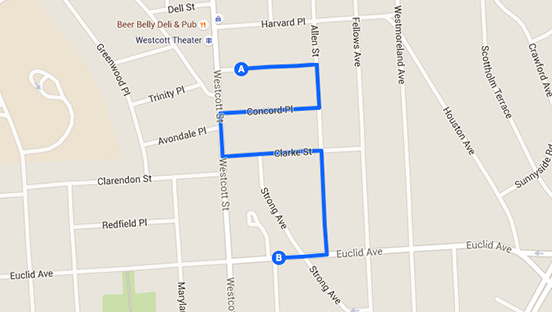
The streets on this tour represent, for the most part, the imposition of a regular grid upon the Westcott area.
Most of the area included on this tour was farmland purchased on January 25, 1865 from the State of New York by Herman H. Stanton who created the Stanton Farm carriage-driving course, a popular place to visit from 1868 through the 1870s. The driving course was laid out when Stanton leased part of his farm to the Syracuse Driving Park Association, of which Richard W. Jones was president. The course consisted of a half-mile track with grandstand with on-site stables and other out buildings. The track was a large oval located between what is now Harvard Pl., Allen St., Clarke St., and Westcott St. In 1872 the 21 acres containing the driving park were deeded to the Association. Stephen Bastable bought the driving park on April 4, 1881, after which it was divided into building lots and platted as the Hillsdale tract.
The name Hillsdale came from Wickliffe A. Hill who owned a 1/3 interest in the tract from 1889 to 1890. Concord Place was originally to be named Wycliffe Street or Place, and was a simple straight street between Westcott and Allen Streets. Contrary to common belief, today’s Concord Place, with its unusual elongated oval form, is not a continuation of the driving course, but it is a reflection of popular English Park designs.
Though Hillsdale was promoted in the 1880s, only a few houses were built before 1900, at which time residential development in the area increased rapidly and continued through the 1920s. The oldest houses include a few Queen Anne or Princess Anne style residences on Victoria Place, and more houses along the neighborhood’s oldest street; Strong Avenue between Euclid and Clarke (which existed before the grid and was part of an earlier Indian Trail dating before white settlement of the area). Like its continuation (South Beech) across Westcott, the street has narrow building lots (on just the east side) that are at odds with the rest of the area. On these lots are some fine, tall, sturdy houses from the late 1880s and 1890s.
There are also a few select number of early Arts & Crafts style houses on the corner lots where Victoria and Concord Places and Clarke Street meet Allen Street. These unique architect-designed houses beautify their lots and are one reason that walking in this neighborhood is so pleasant and interesting. The Arts & Crafts houses present new and delightful building shapes, decorations and colors breaking up the impressive but sometimes monotonous rows of American four-square houses, colonials and double-decker flats.
©2015 Samuel Gruber. All content is licensed under the Creative Commons Attribution-NonCommercial 4.0 International (CC BY-NC 4.0)
